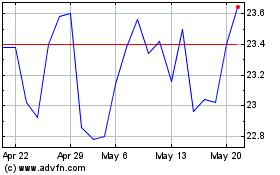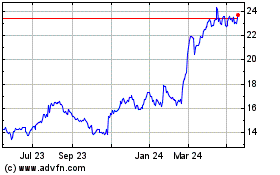Search Area for Malaysia's Flight 370 Is Shifted
December 03 2015 - 4:20AM
Dow Jones News
SYDNEY—Australian authorities have again shifted the search area
for Malaysia Airlines Flight 370, after new analysis suggested the
plane may have glided further than previously thought after running
out of fuel.
The shift adds 21,000 square kilometers (8,108 square miles) of
ocean floor to the search zone—an area roughly the size of the
state of Vermont—and casts doubt on areas previously scoured by a
fleet of ships as part of an expensive underwater search mission
that has spanned more than 13 months.
The Australian Transport Safety Bureau, which is coordinating
the search on behalf of the Malaysian government, said only 54,000
square kilometers of the newly defined area had been searched so
far. That leaves a further 44,000 square kilometers to be searched,
which will likely take until June.
To date, 76,000 square kilometers of the sea floor has been
scanned by towed sonar devices pulled on long cables behind boats,
with around a third of that in areas to the north that experts have
now discredited.
Australia's Deputy Prime Minister Warren Truss said the new
analysis "built on some of the other research that's been
undertaken by international agencies" and drew on "satellite
communications data, aircraft dynamics, [and] meteorological data"
provided to Australian defense officials by multinational
experts.
"The key outcome of this additional work validates what has
happened so far," he said Thursday, noting the focus had now
shifted to the southern end of the previous search area, and the
search area had been widened. An ATSB spokesman said the new search
area was now 30 kilometers wider than before.
Malaysia Airlines Flight 370 has been missing since March 2014,
when it veered sharply off course while on a scheduled flight from
Kuala Lumpur to Beijing. The plane was picked up briefly on local
radar screens before disappearing over the Indian Ocean. All 239
passengers and crew are presumed dead.
The only debris found from the missing aircraft was a small wing
part known as a flaperon that in July was found washed ashore on
the Indian Ocean island of Ré union. Experts believe the wing part
was carried by strong ocean currents thousands of kilometers west
from the search zone off the coast of Western Australia. French
authorities are still analyzing the flaperon for clues.
As officials continue searching for the missing Boeing jet,
Southeast Asia's aviation industry has been hit by other safety
concerns. On Wednesday, the U.S. Federal Aviation Administration
downgraded Thailand's aviation industry to category two status
after audits revealed lax safety oversight by the nation's aviation
regulator. On Tuesday, a report released by Indonesian accident
investigators about the crash of AirAsia Flight 8501, which killed
162 people after a high-altitude stall over the Java Sea last
December, cast doubt on maintenance and pilot training at the
airline. AirAsia said it had made safety changes since the crash to
address these problems.
While questions about regional air safety mount, authorities
have struggled to provide answers about what happened to Flight
370. And the underwater search for the plane using towed sonar
detectors, which began late last year after aerial searches for
debris turned up only garbage, has been hit by multiple
setbacks.
Scientists and mathematicians have readjusted their assumptions
about the where the plane went down a number of times after
reanalyzing communications from the plane with an Inmarsat PLC
satellite, and reassessing the performance characteristics of the
Boeing aircraft with the help of the manufacturer.
Searchers have also faced foul weather, equipment failures and
more recently two medical emergencies that have delayed
operations.
The new analysis carried out by the Australian Defence Science
and Technology Group, a government research and development team,
raised the possibility that the plane glided as far as 100 nautical
miles, or 180 kilometers, from its last point of communication with
the Inmarsat PLC satellite.
"If this low probability area is to be searched, further
analysis will be needed," the researchers said.
The governments of Australia, Malaysia and China have committed
to searching a total of 120,000 square kilometers before suspending
the search, after earlier outlining a 60,000 square kilometer
search area that relatives of the missing passengers claimed wasn't
exhaustive enough.
The Chinese government recently committed to providing an extra
ship to the search, alongside 20 million Australian dollars
(US$14.6 million) to aid operations. Australia has already pledged
A$60 million to carry out the underwater search and in August last
year contracted Dutch oil and gas firm Fugro NV to look for the
plane. Malaysia has agreed to match Australia's contribution, and
hired its own ship which has since left the search.
Other countries including Japan, the United Kingdom and New
Zealand also sent military aircraft and ships to help in the early
phases of searching. The combined total cost of the search for
Flight 370 is now around A$180 million so far, Australia's deputy
prime minister said Thursday.
Write to Daniel Stacey at daniel.stacey@wsj.com
Subscribe to WSJ: http://online.wsj.com?mod=djnwires
(END) Dow Jones Newswires
December 03, 2015 04:05 ET (09:05 GMT)
Copyright (c) 2015 Dow Jones & Company, Inc.
Fugro NV (EU:FUR)
Historical Stock Chart
From Mar 2024 to Apr 2024

Fugro NV (EU:FUR)
Historical Stock Chart
From Apr 2023 to Apr 2024
